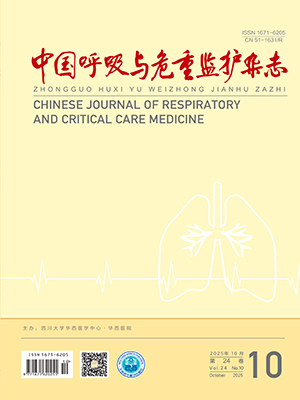| 1. |
Gennimata SA, Palamidas A, Karakontaki F, et al. Pathophysiology of evolution of small airways disease to overt COPD. COPD, 2010, 7(4): 269-275.
|
| 2. |
Calverley PM, Koulouris NG. Flow limitation and dynamic hyperinflation: key concepts in modern respiratory physiology. Eur Respir J, 2005, 25(1): 186-199.
|
| 3. |
Pepe PE, Marini JJ. Occult positive end-expiratory pressure in mechanically ventilated patients with airflow obstruction: the auto-PEEP effect. Am Rev Respir Dis, 1982, 126(1): 166-170.
|
| 4. |
Eltayara L, Becklake MR, Volta CA, et al. Relationship between chronic dyspnea and expiratory flow limitation in patients with chronic obstructive pulmonary disease. Am J Respir Crit Care Med, 1996, 154(6 Pt 1): 1726-1734.
|
| 5. |
Boni E, Corda L, Franchini D, et al. Volume effect and exertional dyspnoea after bronchodilator in patients with COPD with and without expiratory flow limitation at rest. Thorax, 2002, 57(6): 528-532.
|
| 6. |
Appendini L, Purro A, Patessio A, et al. Partitioning of inspiratory muscle workload and pressure assistance in ventilator-dependent COPD patients. Am J Respir Crit Care Med, 1996, 154(5): 1301-1309.
|
| 7. |
Ambrosino N, Nava S, Torbicki A, et al. Haemodynamic effects of pressure support and PEEP ventilation by nasal route in patients with stable chronic obstructive pulmonary disease. Thorax, 1993, 48(5): 523-528.
|
| 8. |
Ranieri VM, Dambrosio M, Brienza N. Intrinsic PEEP and cardiopulmonary interaction in patients with COPD and acute ventilatory failure. Eur Respir J, 1996, 9(6): 1283-1292.
|
| 9. |
Dellacà RL, Santus P, Aliverti A, et al. Detection of expiratory flow limitation in COPD using the forced oscillation technique. Eur Respir J, 2004, 23(2): 232-240.
|
| 10. |
Dellacà RL, Rotger M, Aliverti A, et al. Noninvasive detection of expiratory flow limitation in COPD patients during nasal CPAP. Eur Respir J, 2006, 27(5): 983-991.
|
| 11. |
朱蕾. 临床肺功能. 北京, 人民卫生出版社, 2004.
|
| 12. |
Koulouris NG, Kaltsakas G, Palamidas AF, et al. Methods for assessing expiratory flow limitation during tidal breathing in COPD patients. Pulm Med, 2012, 2012: 234145.
|
| 13. |
Akita T, Shirai T, Mori K, et al. Association of the forced oscillation technique with negative expiratory pressure in COPD. Respir Physiol Neurobiol, 2016, 220: 62-68.
|
| 14. |
Dellacà RL, Duffy N, Pompilio PP, et al. Expiratory flow limitation detected by forced oscillation and negative expiratory pressure. Eur Respir J, 2007, 29(2): 363-374.
|
| 15. |
Mead J , Whittenberger JL. Physical properties of human lungs measured during spontaneous respiration. J Appl Physiol, 1953, 5(12): 779-796.
|
| 16. |
Morgenthaler TI, Aurora RN, Brown T, et al. Practice parameters for the use of autotitrating continuous positive airway pressure devices for titrating pressures and treating adult patients with obstructive sleep apnea syndrome: an update for 2007. An American Academy of Sleep Medicine report. Sleep, 2008, 31(1): 141-147.
|
| 17. |
王华. 强迫振荡技术在无创正压通气中的应用研究. 广州医学院, 2008.
|
| 18. |
Farre R, Gavela E, Rotger M, et al. Noninvasive assessment of respiratory resistance in severe chronic respiratory patients with nasal CPAP. Eur Respir J, 2000, 15(2): 314-319.
|
| 19. |
王华, 杨宗瑜, 刘杰, 等. 应用电抗评估重度COPD患者气流受限的程度及无创正压通气的效果. 中国呼吸与危重监护杂志, 2009, 8(2): 156-161.
|
| 20. |
Lorx A, Czövek D, Gingl Z, et al. Airway dynamics in COPD patients by within-breath impedance tracking: effects of continuous positive airway pressure. Eur Respir J, 2017, 49(2): 1601270.
|
| 21. |
Milesi I, Porta R, Cacciatore S, et al. Effects of automatic tailoring of positive end expiratory pressure (PEEP) by forced oscillation technique (FOT) during nocturnal non-invasive ventilation (NIV) in chronic obstructive pulmonary disease (COPD). Eur Respir J, 2017, 50(Suppl 61): PA2179.
|
| 22. |
Milesi I, Porta R, Vitacca M, et al. Effects of nocturnal Non-Invasive Ventilation (NIV) with automatic tailoring of Positive End Expiratory Pressure (PEEP) on gas exchange and patientventilator interaction in COPD (Chronic Obstructive Pulmonary Disease). Eur Respir J, 2018, 2(Suppl 62): PA1664.
|
| 23. |
Milesi I, Porta R, Barbano L, et al. Automatic tailoring of the lowest PEEP to abolish tidal expiratory flow limitation in seated and supine COPD patients. Respir Med, 2019, 155: 13-18.
|
| 24. |
Zannin E, Chakrabarti B, Govoni L, et al. Detection of Expiratory Flow Limitation by Forced Oscillations during Noninvasive Ventilation. Am J Respir Crit Care Med, 2019, 200(8): 1063-1065.
|
| 25. |
Zannin E, Milesi I, Porta R, et al. Effect of nocturnal EPAP titration to abolish tidal expiratory flow limitation in COPD patients with chronic hypercapnia: a randomized, cross-over pilot study. Respir Res, 2020, 21(1): 301.
|
| 26. |
Suh ES, Pompilio P, Mandal S, et al. Autotitrating external positive end-expiratory airway pressure to abolish expiratory flow limitation during tidal breathing in patients with severe COPD: a physiological study. Eur Respir J, 2020, 56(3): 1902234.
|
| 27. |
McKenzie J, Nisha P, Cannon-Bailey S, et al. Overnight variation in tidal expiratory flow limitation in COPD patients and its correction: an observational study. Respir Res, 2021, 22(1): 319.
|
| 28. |
Farre R, Peslin R, Rotger M, et al. Inspiratory dynamic obstruction detected by forced oscillation during CPAP. A model study. Am J Respir Crit Care Med, 1997, 155(3): 952-956.
|
| 29. |
Zimmermann SC, Tonga KO, Thamrin C. Dismantling airway disease with the use of new pulmonary function indices. Eur Respir Rev, 2019, 28(151): 180122.
|
| 30. |
Farré R, Rigau J, Montserrat JM, et al. Evaluation of a simplified oscillation technique for assessing airway obstruction in sleep apnoea. Eur Respir J, 2001, 17(3): 456-461.
|
| 31. |
王华, 陈荣昌, 何晟, 等. 应用强迫振荡技术优化慢性阻塞性肺疾病患者经鼻罩无创通气压力水平的探讨. 中华结核和呼吸杂志, 2009, 32(1): 21-26.
|
| 32. |
中华医学会重症医学分会. 慢性阻塞性肺疾病急性加重患者的机械通气指南(2007). 中国危重病急救医学, 2007, 19(9): 513-518.
|




